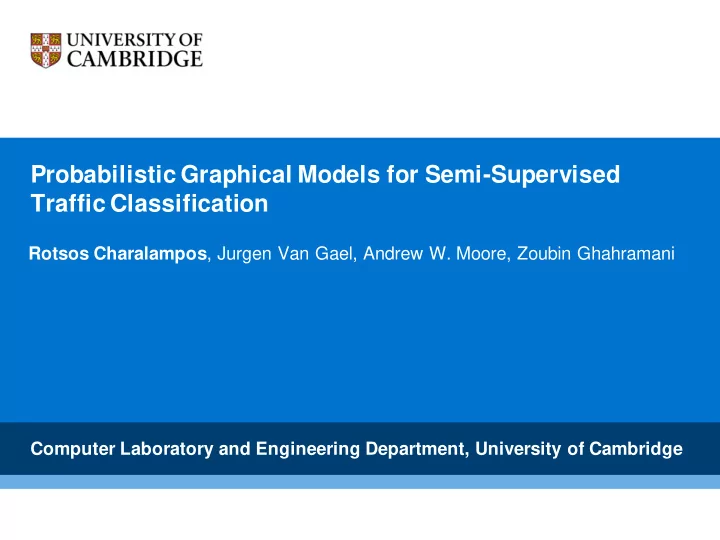

Probabilistic Graphical Models for Semi-Supervised Traffic Classification Rotsos Charalampos , Jurgen Van Gael, Andrew W. Moore, Zoubin Ghahramani Computer Laboratory and Engineering Department, University of Cambridge
Traffic classification • Traffic classification is the problem of defining the application class of a network flow by inspecting its packets. • port-based pattern match statistical analysis. • Useful in order to perform other network functions: • Security : Fine grain access control, valuable dimension for analysis • Network Management : network planning, QoS • Performance measurement: Performance dependence on traffic class
Problem Space • So far research focuses on packet-level measurement with good results. • But no systems implementations, because… Required measurements are difficult Focus on flow records. Existing research exhibit encouraging results. Inflexible and generic models use modern ML techniques (Bayesian Modeling, Probabilistic graphical models) Develop a problem specific ML-model with well defined parameters Since records are sensitive to minor network changes, use semi- supervised learning
Outline • Model Presentation • Results • Related work • Further Development
Problem definition • N flows extracted from a router each having M feauture. • Each flow is represented by a vector x i that has set of features x ij with 0 < j ≤ M and 0< I ≤ N. • Each flow has an application class c i . • Assume that we have L flows labeled and U flow unlabeled with L+U = N. • Define f(.) such as , If X i ∈ U , f( X i | C L , L) = c i • Assume that flow records are generated without any sampling applied and x ij are independent .
Probabilistic Graphical Models • Diagrammatic representations of probability distributions • Directed acyclic graphs represent conditional dependence among R.V. • Easy to perform inference P(a,b,c) = P(a) P(b | a) P(c | a,b) • Simple graph manipulation can give us complex distributions. • Advantages: • Modularity • Iterative design • Unifying framework
Generative model • φ is the parameter of the class distribution and θ kj is the parameter of the distribution of feature j for class k. • Graph model similar to supervised Naïve Bayes Model. • Assume θ kj ~ Dir( α θ ) and φ ~ Dir( α φ ). • Use bayesian approach to calculate parameter distribution.
Semi supervised learning • Hybrid approach of supervised and unsupervised learning • Train using a labeled dataset and extend model by integrating newly labelled datapoints. • Advantages: Reduced training dataset. Increased accuracy when the model is correct. Highly configurable when used with Bayesian modeling. • Disadvantages Computationally complex .
Semi supervised graphical model • Calculating parameter increases exponentially as new unlabled datapoint are added. • Hard rd assign ignment nt: Add newly labelled datapoint to the Cx with the highest posterior probability. • Soft assig ignm nment ent: update the posterior for each parameter according to the predicted weight of the datapoint. • Define class using:
Outline • Model Presentation • Results • Related work • Further Development
Data • 2 day trace from research facility [Li09]. Appr. 6 million tcp flows. • Ground-truth using GTVS tool. • Netflow records exported using nProbe. Settings similar to a Tier-1 ISP. • Model implemented in C#. Also used the Naïve Bayes with kernel estimation implementation from the Weka Platform. • Feature set: srcIp/dstIP srcPort/dstPort ip tos start/end time tcpFlags bytes # packets time length avg. packet size byte rate packet rate tcpF* (uniq. flag)
Application statistics App % App % App % database 4.3 services 0.03 peer-to-peer 11.47 mail 2.5 Spam filter 0.48 web 72.33 ftp 6.25 streaming 0.31 vpn 0.1 im 0.6 voip 0.16 Remote access 0.61
Baseline comparison
Baseline comparison – Class accuracy
Dataset size
Model parameters
Outline • Model Presentation • Results • Related work • Further Development
Related work • Lots of work on traffic classification using machine learning Survey paper [Ngyen et al, IEEE CST 2008] and method comparison [Kim et al, Connext08] Semi-supervised learning used on packet-level measurements in [Erman et al, Sigmetrics07] Traffic classification using NetFlow data is quite recent First attempt using a Naïve Bayes classifier introduced in [Jiang et al, INM07] Approach to the problem using C4.5 classifier in [Carela-Espanol et al, Technical report 09]
Outline • Model Presentation • Results • Related work • Further Development
Further development • Packet sampling • Difficult problem – multi view points could simplify the problem • Adapt model for host characterization problem • Aggregate traffic on the host level and enrich data dimensions • Incorporate graph level information in the model • Computer networks bares similarities with social networks
Conclusion • Flow records may be a good data primitive for traffic classification. • Modeling using probabilistic graphical model is not very difficult. • Semi supervised learning is an effective concept, but is not a one- solves-all solution. • Our model achieves 5-10% better performance than generic classifier and exhibits a good stability in short scale. • Bayesian modeling and graphical models allow easy integration of domain knowledge and adaptation to the requirements of the user. • Model can be extended to achieve better results.
Recommend
More recommend